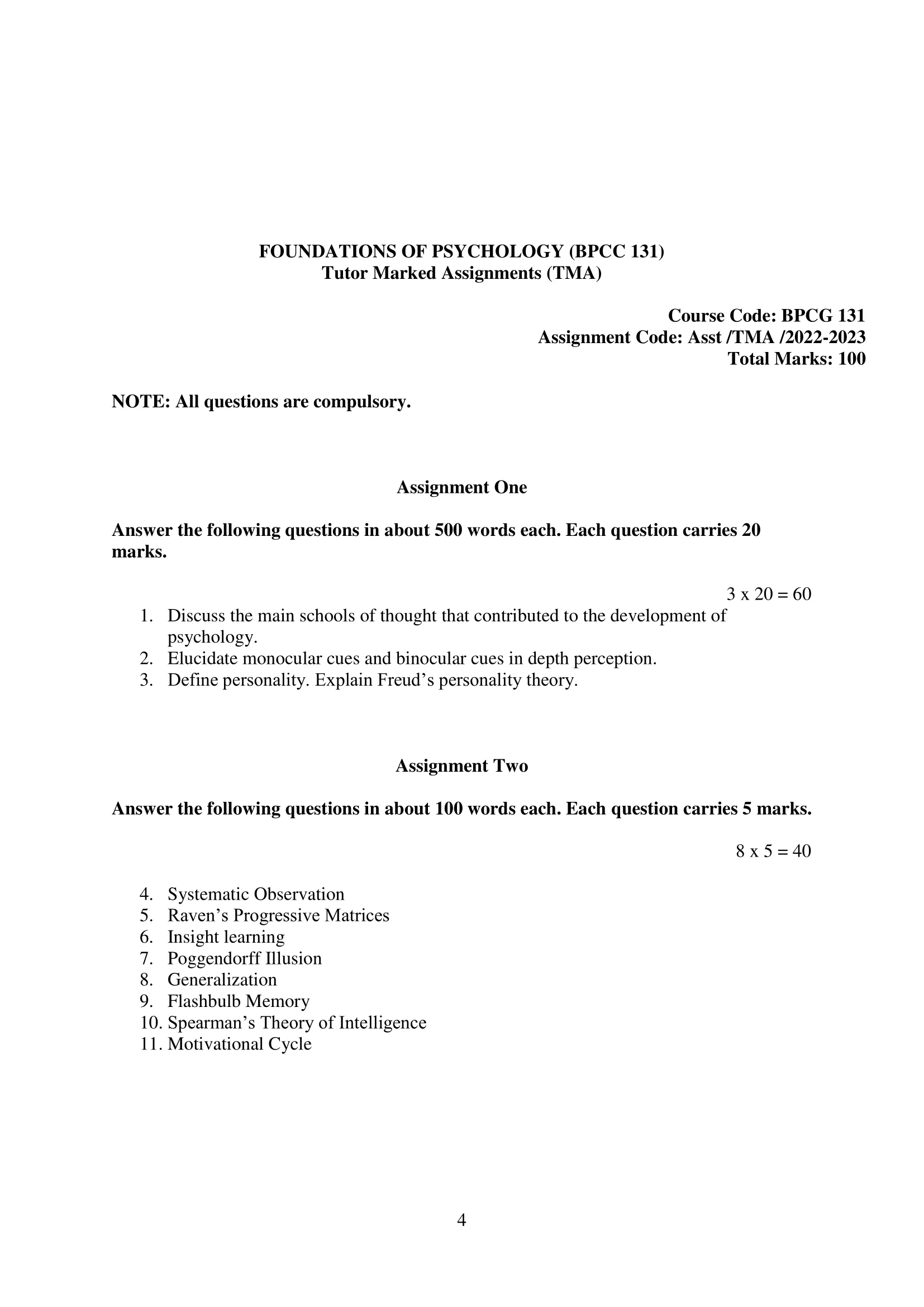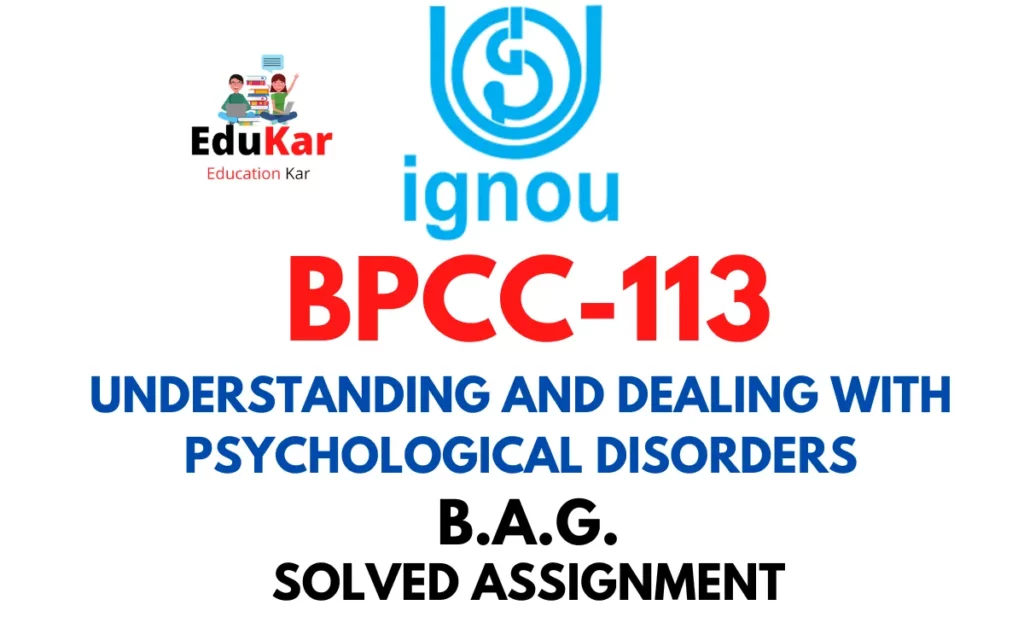Contents
- 1 Assignment One
- 2 Answer the following questions in about 500 words each. Each question carries 20marks.
- 3 1. Discuss the main schools of thought that contributed to the development ofpsychology.
- 4 2. Elucidate monocular cues and binocular cues in depth perception.
- 5 3. Define personality. Explain Freud’s personality theory.
- 6 Assignment Two
- 7 Answer the following questions in about 100 words each. Each question carries 5 marks.
- 8 4. Systematic Observation
- 9 5. Raven’s Progressive Matrices
- 10 6. Insight learning
- 11 7. Poggendorff Illusion
- 12 8. Generalization
- 13 9. Flashbulb Memory
- 14 10. Spearman’s Theory of Intelligence
- 15 11. Motivational Cycle

| Title | BPCC-131: IGNOU BAG Solved Assignment 2022-2023 |
| University | IGNOU |
| Degree | Bachelor Degree Programme |
| Course Code | BPCC-131 |
| Course Name | FOUNDATIONS OF PSYCHOLOGY |
| Programme Name | Bachelor of Arts (General) |
| Programme Code | BAG |
| Total Marks | 100 |
| Year | 2022-2023 |
| Language | English |
| Assignment Code | Asst /TMA /2022-2023 |
| Last Date for Submission of Assignment: | For June Examination: 31st April For December Examination: 30th September |

Assignment One
Answer the following questions in about 500 words each. Each question carries 20
marks.
1. Discuss the main schools of thought that contributed to the development of
psychology.
Ans: Psychology is a scientific discipline that studies human behavior, mental processes, and experiences. Over the years, psychology has evolved and developed through various schools of thought that have contributed to its advancement. The following are some of the main schools of thought that have significantly influenced the development of psychology:
- Structuralism: This school of thought was developed by Wilhelm Wundt, who is considered the father of modern psychology. Structuralism aimed to understand the structure of conscious experience by breaking it down into its basic components or elements. According to structuralists, the mind could be studied through introspection, or the systematic observation of one’s own thoughts and experiences.
- Functionalism: This school of thought was developed by William James, who believed that the mind was a constantly changing stream of thoughts and experiences. Functionalists focused on the adaptive functions of behavior and mental processes and aimed to understand how they helped individuals to survive and thrive in their environments. They believed that psychology should have practical applications that could improve people’s lives.
- Behaviorism: Behaviorism emerged in the early 20th century and was developed by John Watson and B.F. Skinner. Behaviorists believed that psychology should only focus on observable and measurable behaviors, not on mental processes, which were considered too subjective. They emphasized the importance of environmental factors in shaping behavior and believed that all behavior was learned through conditioning.
- Gestalt psychology: This school of thought was developed in Germany in the early 20th century by Max Wertheimer, Wolfgang Kohler, and Kurt Koffka. Gestalt psychologists believed that the whole was greater than the sum of its parts, and focused on the study of perception, problem-solving, and creative thinking. They emphasized the importance of context and the way that people organize sensory information into meaningful wholes.
- Psychoanalysis: This school of thought was developed by Sigmund Freud and focused on the unconscious mind and the role of early childhood experiences in shaping personality and behavior. Psychoanalysts believed that mental disorders and maladaptive behaviors were caused by repressed emotions and unresolved conflicts that needed to be brought to consciousness through psychotherapy.
- Humanistic psychology: This school of thought emerged in the 1950s and was developed by Abraham Maslow and Carl Rogers. Humanistic psychologists focused on the study of self-actualization, personal growth, and the potential of human beings to achieve their full potential. They believed that people had an inherent drive towards growth and self-fulfillment, and that the role of psychology was to help individuals to achieve these goals.
2. Elucidate monocular cues and binocular cues in depth perception.
Ans: Depth perception is the ability to perceive the distance of objects in the environment. It is an essential aspect of vision that allows us to interact with the world around us. There are two types of cues that contribute to depth perception: monocular and binocular cues.
Monocular cues are visual cues that can be perceived with only one eye. They provide information about depth and distance through the use of size, texture, and perspective. Monocular cues are used by the brain to create a 3D representation of the environment, even when viewed through a 2D medium such as a photograph or a painting.
Some of the most common monocular cues include:
- Relative size: When two objects are the same size, the object that appears smaller is perceived as being farther away.
- Overlap or interposition: When one object partially covers another, the object that is covered is perceived as being farther away.
- Texture gradient: The texture of objects becomes less detailed as they recede into the distance, giving the impression of depth.
- Linear perspective: Parallel lines appear to converge as they recede into the distance, giving the impression of depth.
- Aerial perspective: Objects in the distance appear hazy and less distinct due to the scattering of light by the atmosphere, giving the impression of depth.
Binocular cues, on the other hand, are visual cues that require both eyes to be perceived. They provide information about depth and distance through the use of retinal disparity, which is the difference in the images that the two eyes receive. The brain uses retinal disparity to calculate the distance of objects in the environment and to create a 3D representation of the world.
Some of the most common binocular cues include:
- Convergence: When the eyes converge on a single object, the degree of muscular effort required provides information about the distance of the object.
- Stereopsis: When the brain compares the images from the two eyes, it creates a sense of depth and dimensionality.
- Binocular summation: When the images from the two eyes are combined, the resulting image is brighter and sharper than either image alone.
3. Define personality. Explain Freud’s personality theory.
Ans: Personality refers to the unique and enduring patterns of thoughts, feelings, and behaviors that distinguish individuals from one another. It is a complex and multifaceted concept that is influenced by a range of factors, including genetics, environment, and life experiences.
Sigmund Freud, the founder of psychoanalysis, proposed a comprehensive theory of personality that is still influential in contemporary psychology. According to Freud, the personality is composed of three main components: the id, the ego, and the superego.
The id is the primitive and instinctual part of the personality that is present from birth. It operates according to the pleasure principle and seeks to satisfy basic biological needs, such as hunger, thirst, and sexual desire. The id is impulsive, irrational, and uninhibited, and it seeks immediate gratification without regard for social norms or consequences.
The ego is the rational and logical part of the personality that develops as a result of socialization and the demands of the external environment. It operates according to the reality principle and seeks to balance the desires of the id with the demands of the environment. The ego helps to mediate between the id and the superego and is responsible for managing conflicts between the two.
The superego is the moral and ethical part of the personality that develops as a result of socialization and the internalization of cultural and societal values. It operates according to the ideal principle and seeks to uphold moral standards and values, even if it means going against the desires of the id or the ego. The superego is often described as the “conscience” of the personality and is responsible for feelings of guilt and shame.
Freud also proposed that the personality is structured into three levels of awareness: the conscious, the preconscious, and the unconscious. The conscious level refers to thoughts, feelings, and behaviors that are currently in awareness. The preconscious level refers to information that is not currently in awareness but can be easily retrieved. The unconscious level refers to thoughts, feelings, and behaviors that are outside of awareness and are often repressed due to their threatening or unacceptable nature.
In addition to these components, Freud also proposed a developmental theory of personality that consists of five psychosexual stages: the oral stage, the anal stage, the phallic stage, the latency stage, and the genital stage. According to Freud, each stage is associated with a particular erogenous zone and a corresponding psychological conflict that must be resolved in order for healthy personality development to occur.
Assignment Two
Answer the following questions in about 100 words each. Each question carries 5 marks.
4. Systematic Observation
Ans: Systematic observation is a research method that involves observing and recording behavior or events in a structured and systematic manner. This method is commonly used in social and behavioral sciences to gather data on various phenomena such as human behavior, animal behavior, and social interactions. Systematic observation involves developing a clear set of procedures for observing and recording data, often using coding schemes or rating scales to quantify observations. The resulting data can be analyzed to identify patterns, trends, and relationships between variables of interest. This method is often used in combination with other research methods to provide a more comprehensive understanding of a phenomenon.
5. Raven’s Progressive Matrices
Ans: Raven’s Progressive Matrices is a non-verbal intelligence test developed by John C. Raven in the 1930s. The test is designed to measure a person’s ability to solve problems, think abstractly, and reason logically. It consists of a series of visual puzzles, where the test-taker is shown a matrix of shapes with one missing piece, and is asked to choose the piece that would complete the pattern from a set of options.
The test is widely used in both academic and corporate settings as a measure of cognitive ability, particularly in areas such as problem-solving, decision-making, and strategic thinking. It is also used in psychology and neuropsychology research as a tool for assessing cognitive functioning.
Raven’s Progressive Matrices is considered a culturally fair test, as it does not rely on verbal or cultural knowledge, and has been shown to be less affected by factors such as education, language, and socio-economic background than traditional intelligence tests. However, it is not without limitations, and has been criticized for its reliance on abstract reasoning and pattern recognition, which may not fully capture all aspects of intelligence.
6. Insight learning
Ans: Insight learning is a form of problem-solving that occurs when an individual suddenly realizes how to solve a problem without a gradual process of trial-and-error learning. In insight learning, the individual has a sudden understanding of the problem, often resulting in an “aha!” moment.
The concept of insight learning was first introduced by German psychologist Wolfgang Kohler in the early 20th century, who studied chimpanzees and observed that they were capable of solving problems through insight rather than just through trial-and-error learning.
Insight learning is characterized by sudden, unexpected, and often novel solutions to problems. The solution often involves a new way of thinking about the problem, or a new way of approaching the problem that was not apparent before. In contrast to trial-and-error learning, insight learning often involves the use of mental imagery, imagination, and cognitive restructuring.
Insight learning is thought to occur when an individual has a “mental set” or a rigid way of thinking about a problem that prevents them from seeing alternative solutions. When the individual is able to overcome this mental set and restructure their thinking about the problem, they are able to arrive at an insight that leads to the solution.
7. Poggendorff Illusion
Ans: The Poggendorff illusion is an optical illusion that demonstrates the influence of oblique lines on the perception of angles. It was first described by German physicist Johann Poggendorff in 1860.
The illusion occurs when a diagonal line is interrupted by a rectangle, creating an angle. When the angle is presented in isolation, it appears to be misaligned with the rest of the diagonal line. However, when the diagonal line is extended and intersected with a vertical or horizontal line, the angle appears to align with the diagonal line.
The Poggendorff illusion is thought to be caused by the brain’s tendency to group objects based on their orientation. The diagonal line and the vertical/horizontal line are grouped separately, so the angle between them is perceived as misaligned. However, when the diagonal line is extended to intersect with the vertical/horizontal line, the grouping changes, and the brain perceives the angle as aligned with the diagonal line.
The Poggendorff illusion is a classic example of how perception can be influenced by context, and how the brain uses heuristics to make sense of visual information. It is often used in psychology and neuroscience research to study the underlying mechanisms of visual perception and the processing of spatial information.
8. Generalization
Ans: Generalization is a cognitive process by which an individual responds to a new situation or stimulus based on past experiences with similar situations or stimuli. Generalization occurs when an individual applies previously learned knowledge or behavior to a new context, without necessarily being taught or instructed to do so.
For example, a child who learns to call a cat a “kitty” may generalize this label to other furry animals, such as dogs or rabbits, because they share similar physical characteristics. In another example, a person who is afraid of dogs may generalize this fear to other four-legged animals, such as cats or even cows.
Generalization is an important aspect of learning and cognition, as it allows individuals to apply their knowledge and skills in a flexible and adaptive manner. However, generalization can also lead to errors or biases in perception and decision-making, especially when the new situation or stimulus is not actually similar to the original one.
In psychology, generalization is often studied in the context of learning and memory, as well as in the development of cognitive and behavioral therapies. By understanding how generalization occurs and how it can be influenced, psychologists can help individuals overcome maladaptive or phobic responses, and develop more flexible and adaptive ways of thinking and behaving.
9. Flashbulb Memory
Ans: Flashbulb memory is a type of vivid and long-lasting memory that is created in response to a significant and emotionally arousing event. Flashbulb memories are highly detailed and can include information such as the time, place, and emotions experienced at the time of the event.
Examples of events that may give rise to flashbulb memories include natural disasters, terrorist attacks, major accidents, or the death of a loved one. These events are typically unexpected and emotionally arousing, which can lead to the formation of a strong and lasting memory.
Flashbulb memories are distinct from other types of memories in that they are believed to be stored in a different way in the brain. They are thought to involve a more complex neural process than other memories, which may account for their strength and durability.
Although flashbulb memories are highly detailed and long-lasting, they are not immune to errors or distortions. People may remember details that did not actually happen or forget important details that were present. Over time, memories may also change as a result of new information or experiences.
Flashbulb memories have been studied extensively in psychology, and researchers have sought to understand how they are formed and why they are so long-lasting. The study of flashbulb memories has important implications for our understanding of memory, emotion, and the effects of significant events on our lives.
10. Spearman’s Theory of Intelligence
Ans: Spearman’s theory of intelligence, also known as the two-factor theory of intelligence, was proposed by British psychologist Charles Spearman in the early 20th century. This theory suggests that intelligence is made up of two components: a general factor (known as the “g factor”) and specific factors (known as “s factors”).
The “g factor” refers to the general intelligence that underlies all intellectual abilities. According to Spearman, this factor represents a broad mental capacity that is present to some degree in all cognitive tasks. The “s factors” represent specific abilities that are unique to particular tasks or areas of knowledge, such as musical ability, spatial reasoning, or verbal fluency.
Spearman’s theory of intelligence suggests that intelligence is a unitary trait that can be measured using standardized tests, and that individual differences in intelligence are largely determined by differences in the “g factor.” This idea is supported by research showing that scores on different cognitive tests are often highly correlated, suggesting that there is a common factor underlying performance on these tests.
Spearman’s theory of intelligence has been influential in the field of psychology and has informed the development of many intelligence tests. However, some critics have argued that the theory oversimplifies the complex nature of intelligence and may not fully capture the full range of human cognitive abilities.
Despite its limitations, Spearman’s theory of intelligence remains an important theoretical framework for understanding individual differences in cognitive ability and has played an important role in the development of intelligence testing and research.
11. Motivational Cycle
Ans: The motivational cycle, also known as the motivational process, is a theoretical framework for understanding how motivation operates in individuals. The cycle is made up of four stages:
- Drive: This stage represents the initial state of motivation, in which an individual experiences a need or desire that requires fulfillment. This need may be physiological (such as hunger or thirst) or psychological (such as a desire for social interaction or achievement).
- Cues: In this stage, an individual seeks out information or cues that can help satisfy their drive or need. These cues may include external stimuli (such as food or social interaction) or internal mental processes (such as imagining success).
- Response: This stage involves the behavioral or cognitive response to the cues identified in the previous stage. The response is intended to reduce the drive or satisfy the need identified in the first stage.
- Reinforcement: In the final stage, the response is reinforced or punished based on its effectiveness in reducing the drive or satisfying the need. Reinforcement may come from external sources (such as praise or rewards) or internal sources (such as feelings of satisfaction or accomplishment).
The motivational cycle is a useful framework for understanding how individuals become motivated and how that motivation is sustained over time. It has been used in a variety of fields, including education, sports psychology, and organizational behavior, to develop strategies for motivating individuals and achieving desired outcomes.
It is important to note that the motivational cycle is not a one-time process, but rather a continuous cycle that can be repeated as new drives or needs arise. Additionally, the cycle is influenced by a variety of factors, including personality, environment, and past experiences, which can all affect an individual’s motivation and response to cues.
How to Download BPCC-131 Solved Assignment?
You can download it from the www.edukar.in, they have a big database for all the IGNOU solved assignments.
Is the BPCC-131 Solved Assignment Free?
Yes this is absolutely free to download the solved assignment from www.edukar.in
What is the last submission date for BPCC-131 Solved Assignment?
For June Examination: 31st April, For December Examination: 30th October




![Best 5 Speech on Yoga [Long & Short] Speech-on-Yoga](https://edukar.in/wp-content/uploads/2023/03/Speech-on-Yoga.webp)


![Speech on Subhash Chandra Bose [Short & Long] Speech-on-Subhash-Chandra-Bose](https://edukar.in/wp-content/uploads/2023/03/Speech-on-Subhash-Chandra-Bose.webp)








